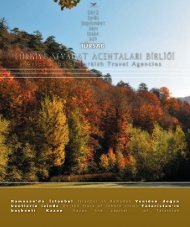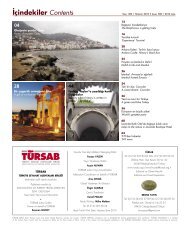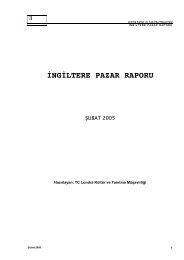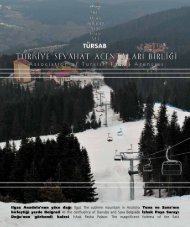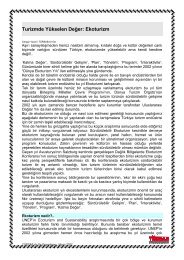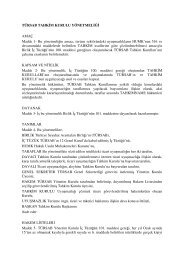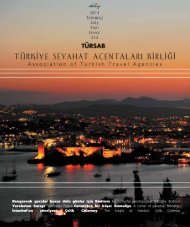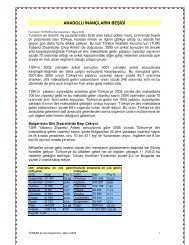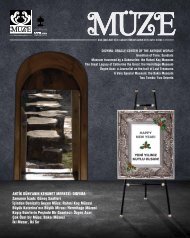Amasya - Türkiye Seyahat Acentaları Birliği
Amasya - Türkiye Seyahat Acentaları Birliği
Amasya - Türkiye Seyahat Acentaları Birliği
- No tags were found...
You also want an ePaper? Increase the reach of your titles
YUMPU automatically turns print PDFs into web optimized ePapers that Google loves.
usy days can meet and talk at thefeast. Families all together share anevening dinner and drink the feastcoffee.Undoubtedly, the most beautifulfeasts are during childhood. Whenyou are a child, the festival days,just like the other things, seem toyou more enchanted or exciting.Moreover, it has two provocativefeatures for the kids, such as eating limitless deserts and gatheringallowances.When we were children, after putting our allowances and Turkish delightsinto our handkerchiefs, we would hide those hand-embroidered handkerchiefs.There is not such a tradition now, but don’t forget to cheer up the kids atthis feast too. Make those tiny kids who come to your door happy, eithergiving them allowance, or making contributions to theireducational life through various organizations.We’ve another suggestion for every one, children andadults alike. Don’t overdo it with deserts! Restrainyourself from eating too much to avoid of any healthproblems.Feast or Bayram means friendship, brotherhoodand peace. It also means 3 beautiful and shinydays that might illuminate our world immersed inmateriality. Let’s appreciate these spiritually rich days thatbring us closer and remind us that others are human just like us. Have agood feast.Ah eski bayramlarAdettendir, bayramın bayram gibi kutlandığı o eski zamanlara yetişemeyenlerbile “Ah eski bayramlar” der durur. Peki nedir hakikaten bu “eski bayramlar”?Osmanlı Dönemi’nde bakın bayramlar nasıl kutlanıyormuş. Yazımızı okuduktansonra artık gerçekten “Ah eski bayramlar” diyebilirsiniz…Osmanlı İmparatorluğu bayram kutlamalarına ayrı bir önem verirdi. İlkresmi düzenleme Fatih Sultan Mehmet Dönemi’nde yapılmıştı. Padişahlarbayramlarda halka açık büyük şenlikler düzenletirdi. Seyirciler yarım ay şeklindeoturur, padişahın otağı da bu yarım ayın tam merkezinde bulunurdu. Padişahotağının sol tarafında ziyafet çadırı yer alırdı. Bayramlarda öğleden öncesibayramlaşma ve ikramla geçer, öğleden sonra da gösteriler yapılırdı. Büyüktörenlerde geceleri kandiller, mahyalar ve fişeklerle donanma düzenlenirdi.Yapılan gösterilerde çeşitli hünerler, esnaf oyunları, sportif müsabakalar yeralırdı. Bayram halkın sokaklarda eğlenmesi ve kaynaşmasıyla geçerdi.Oh, those old good feastsJust like an old cliché, even those who are not old enough to remember those days sayrepeatedly, “Alas, where have those old feasts gone?” So, what are those “old feasts” inreality? Let’s look at how these feasts were celebrated in the Ottoman time. After readingthis passage, you can deservingly say, “Alas, those old feasts.”The Ottoman Empire gave a particular importance to the feast celebrations. The firstofficial arrangement was made in the period of Sultan Mehmet II, the Conqueror. Sultanswould have big public feasts during these festivals. Viewers would sit in a crescent shape,and the Sultan’s pavilion would occupy the center of this crescent. A visitors’ tent was onthe left of Sultan’s pavilion. Part of the day until noon, would be spent for exchangingfestival greetings and treats, then the afternoon would be set aside for many performances.In the big ceremonies, candles would be lit and fireworks would be set off. Performanceswould include varied crafts, skills and sporting competitions.TÜRSAB DERGİ | AĞUSTOS 2013 21



